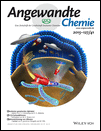A Set of Homo-Oligomeric Standards Allows Accurate Protein Counting
Corresponding Author
Dr. Kieran Finan
Single Molecule Biophysics, Institute for Physical and Theoretical Chemistry, Goethe-University Frankfurt, Max-von-Laue-Strasse 7, 60438 Frankfurt am Main (Germany)
Current address: UCL Medical School, Gower St., London (UK)
Single Molecule Biophysics, Institute for Physical and Theoretical Chemistry, Goethe-University Frankfurt, Max-von-Laue-Strasse 7, 60438 Frankfurt am Main (Germany)Search for more papers by this authorAnika Raulf
Single Molecule Biophysics, Institute for Physical and Theoretical Chemistry, Goethe-University Frankfurt, Max-von-Laue-Strasse 7, 60438 Frankfurt am Main (Germany)
Search for more papers by this authorCorresponding Author
Prof. Dr. Mike Heilemann
Single Molecule Biophysics, Institute for Physical and Theoretical Chemistry, Goethe-University Frankfurt, Max-von-Laue-Strasse 7, 60438 Frankfurt am Main (Germany)
Single Molecule Biophysics, Institute for Physical and Theoretical Chemistry, Goethe-University Frankfurt, Max-von-Laue-Strasse 7, 60438 Frankfurt am Main (Germany)Search for more papers by this authorCorresponding Author
Dr. Kieran Finan
Single Molecule Biophysics, Institute for Physical and Theoretical Chemistry, Goethe-University Frankfurt, Max-von-Laue-Strasse 7, 60438 Frankfurt am Main (Germany)
Current address: UCL Medical School, Gower St., London (UK)
Single Molecule Biophysics, Institute for Physical and Theoretical Chemistry, Goethe-University Frankfurt, Max-von-Laue-Strasse 7, 60438 Frankfurt am Main (Germany)Search for more papers by this authorAnika Raulf
Single Molecule Biophysics, Institute for Physical and Theoretical Chemistry, Goethe-University Frankfurt, Max-von-Laue-Strasse 7, 60438 Frankfurt am Main (Germany)
Search for more papers by this authorCorresponding Author
Prof. Dr. Mike Heilemann
Single Molecule Biophysics, Institute for Physical and Theoretical Chemistry, Goethe-University Frankfurt, Max-von-Laue-Strasse 7, 60438 Frankfurt am Main (Germany)
Single Molecule Biophysics, Institute for Physical and Theoretical Chemistry, Goethe-University Frankfurt, Max-von-Laue-Strasse 7, 60438 Frankfurt am Main (Germany)Search for more papers by this authorAbstract
Techniques based on fluorescence microscopy are increasingly used to count proteins in cells, but few stoichiometrically well-defined standards are available to test their accuracy. A selection of bacterial homo-oligomers were developed that contain 10–24 subunits and fully assemble when expressed in mammalian cells, and they can be used to easily validate/calibrate molecular counting methods. The utility of these standards was demonstrated by showing that nuclear pores contain 32 copies of the Nup107 complex.
Supporting Information
As a service to our authors and readers, this journal provides supporting information supplied by the authors. Such materials are peer reviewed and may be re-organized for online delivery, but are not copy-edited or typeset. Technical support issues arising from supporting information (other than missing files) should be addressed to the authors.
| Filename | Description |
|---|---|
| ange_201505664_sm_miscellaneous_information.pdf1.4 MB | miscellaneous_information |
Please note: The publisher is not responsible for the content or functionality of any supporting information supplied by the authors. Any queries (other than missing content) should be directed to the corresponding author for the article.
References
- 1F. Alber, et al., Nature 2007, 450, 695–701.
- 2K. H. Bui, et al., Cell 2013, 155, 1233–1243.
- 3M. C. Leake, J. H. Chandler, G. H. Wadhams, F. Bai, R. M. Berry, J. P. Armitage, Nature 2006, 443, 355–358.
- 4J. Lawrimore, K. S. Bloom, E. D. Salmon, J. Cell Biol. 2011, 195, 573–582.
- 5V. C. Coffman, P. Wu, M. R. Parthun, J. Q. Wu, J. Cell Biol. 2011, 195, 563–572.
- 6L. Schermelleh, R. Heintzmann, H. Leonhardt, J. Cell Biol. 2010, 190, 165–175.
- 7P. Sengupta, T. Jovanovic-Talisman, D. Skoto, M. Renz, S. L. Veatch, J. Lippincott-Schwartz, Nat. Methods 2011, 8, 969–975.
- 8E. M. Puchner, J. M. Walter, R. Kasper, B. Huang, W. A. Lim, Proc. Natl. Acad. Sci. USA 2013, 110, 16015–16020.
- 9N. Durisic, L. Laparra-Cuervo, A. Sandoval-Alvarez, J. S. Borbely, M. Lakadamyali, Nat. Methods 2014, 11, 156.
- 10U. Endesfelder, K. Finan, S. J. Holden, P. R. Cook, A. N. Kapanidis, M. Heilemann, Biophys. J. 2013, 105, 172–181.
- 11P. Annibale, M. Scarselli, A. Kodiyan, A. Radenovic, J. Phys. Chem. Lett. 2010, 1, 1506–1510.
- 12N. J. Delalez, G. H. Wadhams, G. Rosser, Q. Xue, M. T. Brown, I. M. Dobbie, R. M. Berry, M. C. Leake, J. P. Armitage, Proc. Natl. Acad. Sci. USA 2010, 107, 11347–11351.
- 13A. Charpilienne, M. Nejmeddine, M. Berois, N. Parez, E. Neumann, E. Hewat, G. Trugnan, J. Cohen, J. Biol. Chem. 2001, 276, 29361–29367.
- 14S. Franceschini, P. Ceci, F. Alaleona, E. Chiancone, A. Ilari, FEBS J. 2006, 273, 4913–4928.
- 15S. Thorell, M. Schurmann, G. A. Sprenger, G. Schneider, J. Mol. Biol. 2002, 319, 161–171.
- 16H. S. Gill, D. Eisenberg, Biochemistry 2001, 40, 1903–1912.
- 17T. J. Stillman, P. D. Hempstead, P. J. Artymiuk, S. C. Andrews, A. J. Hudson, A. Treffry, J. R. Guest, P. M. Harrison, J. Mol. Biol. 2001, 307, 587–603.
- 18B. Huang, W. Wang, M. Bates, X. Zhuang, Science 2008, 319, 810–813.
- 19X. Sun, et al., ChemBioChem 2011, 12, 2217–2226.
- 20K. Maeshima, et al., Nat. Struct. Mol. Biol. 2010, 17, 1065–1071.
This is the
German version
of Angewandte Chemie.
Note for articles published since 1962:
Do not cite this version alone.
Take me to the International Edition version with citable page numbers, DOI, and citation export.
We apologize for the inconvenience.




